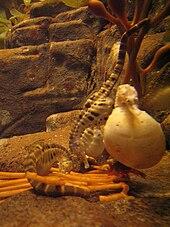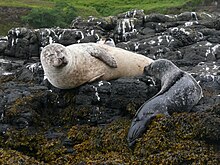Parental care

Parental care is a behavioural and evolutionary strategy adopted by some animals, making a parental investment into the evolutionary fitness of their offspring. This strategy means that more effort is spent on a relatively small number of offspring to give each of them a high chance of surviving to reproduce; an opposite strategy is to produce a very large number of small offspring, often as eggs, which are left to fend for themselves.
Parental care is seen in many insects, notably the social insects such as ants, bees and wasps; in certain fishes, such as the mouthbrooders; widely in birds; and especially widely in mammals, which share two major adaptations for care of the young, namely gestation (development of the embryo inside the mother's body) and production of milk.
In groups of animals
In insects

Some insects, but especially the Hymenoptera (ants, bees and wasps), invest substantial effort in caring for their young. The type and amount of care varies widely. Solitary wasps such as the potter wasps (Eumeninae) build nests for their young, provisioning them with food, often caterpillars, caught by the mother. The nests are then sealed, and the young life on the food until they leave the nest as adults.[1] In contrast, social wasps and honeybees raise young in substantial colonies, with eggs laid mainly by queens (mothers), and the young cared for mainly by workers (sisters of the young).[2]
Outside the Hymenoptera, parental care is found among the burying beetles and the magnificent salt beetle.[3] Subdued forms of parental care are also seen in the Lepidoptera, as in butterflies that lay eggs where the offspring will be able to feed. Crickets have also been known to lay eggs in optimal environments for the young.
In fish

Several different groups of fish have evolved parental care. The young may be guarded by either parent. Some fish such as pipefish, sea dragons and seahorses (Syngnathidae) have a form of male pregnancy, the female taking no part in caring for the young once she has laid her eggs.[4][5] Males in other species may take a role in guarding the eggs before they hatch.
Mouthbrooding is the care given by some groups of fish (and a few other animals such as Darwin's frog) to their offspring by holding them in their mouth for extended periods of time. Mouthbrooding has evolved independently in several different families of fish including the cardinalfish, sea catfish, bagrid catfish, cichlids, snakeheads, jawfishes, gouramis, and arowanas.[6]
In birds
Birds are distinctive in the way they care for their young. In over 90% of birds, both parents help to care for the young. This pattern may have originated in the stem reptiles (archosaurs) that gave rise to the birds, before they developed flight.[7] Most birds, including passerines (perching birds), have their young born blind, naked and helpless (altricial), totally dependent for their survival on parental care. The young are typically raised in a nest; the parents catch food and regurgitate it for the young. Some birds such as pigeons create a "crop milk" which they similarly regurgitate.[8] David Lack developed a hypothesis that clutch size has evolved in response to the costs of parental care known as Lack's principle. It has since seen modifications but is still used as a general model.
In mammals

All the higher mammals (excluding the monotremes, namely the echidna and the platypus) share two major adaptations for care of the young, namely gestation (development of the embryo inside the mother's body, followed by live birth) and production of milk. These imply a group-wide choice of a degree of parental care. Many mammals go much further, building a nest, digging a burrow, or feeding and guarding the young, often for a prolonged period.[9]
In humans


Parenting or child rearing in humans is the process of promoting and supporting the physical, emotional, social, financial, and intellectual development of a child from infancy to adulthood. This goes far beyond anything found in other animals, including not only the provision of food, shelter, and protection from threats such as predators, but a prolonged period of support during which the child learns whatever is needed to live successfully in human society.[10]
In evolutionary biology
In evolutionary biology, parental investment is the expenditure of time and effort that benefits offspring at a cost to parents' ability to invest in other components of fitness. It forms part of one kind of reproductive strategy, choosing to give each of a relatively small number of offspring a relatively high chance of surviving long enough to reproduce themselves, and may accordingly be accompanied by the production of a small number of zygotes at a time, possibly only one.[11][12]
See also
References
- ^ Grissell, E. E. (April 2007). "Potter wasps of Florida". University of Florida. Retrieved 12 June 2015.
- ^ Wong, Janine W. Y.; Meunier, Joel; Molliker, Mathias (2013). "The evolution of parental care in insects: the roles of ecology, life history and the social environment". Ecological Entomology. 38 (2): 123–137. doi:10.1111/een.12000.
- ^ Susan Allport (1 April 2003). A Natural History of Parenting: A Naturalist Looks at Parenting in the Animal World and Ours. iUniverse. pp. 19–20. ISBN 978-0-595-27130-6.
- ^ Wilson, A. B.; Orr, J.W. (2011). "The evolutionary origins of Syngnathidae: pipefishes and seahorses". Journal of Fish Biology. 78 (6): 1603–1623. doi:10.1111/j.1095-8649.2011.02988.x. PMID 21651519.
- ^ Wilson, A. B.; Ahnesjo, I.; Vincent, A.; Meyer, A. (2003). "The dynamics of male brooding, mating patterns, and sex roles in pipefishes and seahorses (family syngnathidae)". Evolution. 57 (6): 1374–1386. doi:10.1111/j.0014-3820.2003.tb00345.x. PMID 12894945.
- ^ Helfman, G., Collette, B, Facey, D. (1997). The Diversity of Fishes. Blackwell. ISBN 0-86542-256-7.
{{cite book}}: CS1 maint: multiple names: authors list (link) - ^ Wesolowski, Tomasz (2004). "The origin of parental care in birds: a reassessment". Behavioral Ecology. 15 (3): 520–523. doi:10.1093/beheco/arh039.
- ^ Ehrlich, Paul R.; Dobkin, David S.; Wheye, Darryl (1988). "Parental Care". Stanford University. Retrieved 15 January 2016.
- ^ David J. Gubernick (11 November 2013). Parental Care in Mammals. Springer Science & Business Media. ISBN 978-1-4613-3150-6.
- ^ Davies, Martin (2000). The Blackwell encyclopedia of social work. Wiley-Blackwell. p. 245. ISBN 978-0-631-21451-9.
- ^ Gilbert, James (30 September 2013). "Evolution of Parental Care". Oxford Bibliographies. Retrieved 15 January 2016.
- ^ Gilbert, James (23 May 2012). "Reproductive Allocation in Animals". Oxford Bibliographies. Retrieved 15 January 2016.

